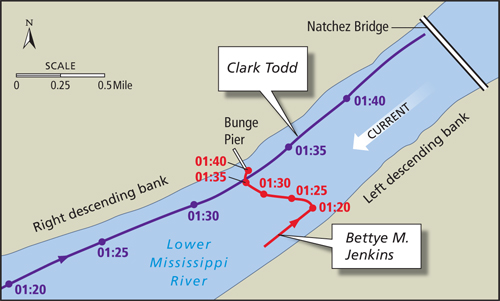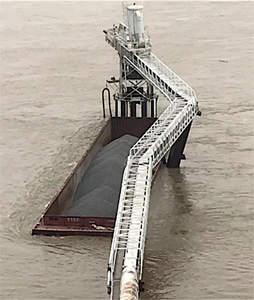Bettye M. Jenkins was upbound with two barges when its captain turned the tow broadside into the flooded Lower Mississippi River with the intention of crossing to calmer current along the right descending bank.
The captain initially planned to pass ahead of another upbound tow, guided by Clark Todd, on that side of the waterway. Instead, Bettye M. Jenkins bogged down in the strong current and was pushed downriver behind Clark Todd. At about 0140 on Feb. 15, 2019, Bettye M. Jenkins’ lead barge struck the conveyor pier at the Bunge grain facility at mile marker 361 near Vidalia, La.
The impact caused the barge to break free and drift downriver into pilings at the site. The terminal sustained extensive damage that prevented loading for almost six months. Repairs cost roughly $3.3 million. No pollution or injuries were reported.
National Transportation Safety Board (NTSB) investigators determined the attempt by Bettye M. Jenkins’ captain to come in front of the upbound tow while crossing the river in high-water conditions was a leading factor in the incident.
“Bettye M. Jenkins attempted to turn upriver after Clark Todd passed ahead of it, but because they had to wait for Clark Todd to clear ahead of them, they turned later than originally planned,” the agency said in its accident report. “The captain of Bettye M. Jenkins stated that along with the difficulty of turning the tow into the high current, his turn was slowed by Clark Todd’s wheelwash. The late turn left the tow too close to the Bunge facility, which the lead barge contacted, parting the tow’s lines.”
The 56-foot, 1,200-hp Bettye M. Jenkins primarily works as a fleet towboat moving barges short distances between and within fleeting areas. The towboat left a fleeting area downriver from the Bunge facility at about 0100 with two crew and two barges loaded with crushed stone.
The tow hugged the left descending bank as it began its transit to Vidalia Dock & Storage, located upriver on the opposite bank just above the Natchez Bridge. The company owns and operates the towboat, which was built in 1959.
The river measured 49.1 feet, or 1.1 feet above flood stage, at the Natchez gauge at the time of the incident. The speed of the current at the time is not known. The Lower Mississippi was in flood stage from Dec. 28, 2018, through Aug. 10, 2019 — the longest stretch on record.
 |
|
An illustration from the NTSB report shows the tracklines of Bettye M. Jenkins and Clark Todd before the impact. |
|
Pat Rossi illustration |
Bettye M. Jenkins and Clark Todd each planned to pass under the west span of the Natchez Bridge, where the current was calmer. Clark Todd was already pushing along the right bank, while Bettye M. Jenkins had to cross to the river to line up ahead of the bridge.
Bettye M. Jenkins’ captain contacted Clark Todd’s pilot shortly before the incident. He requested to pass ahead of Clark Todd and both agreed. Bettye M. Jenkins began turning perpendicular to the current at about 0120. The tow struggled to make the crossing and reportedly “lingered” in the middle of the river, according to Clark Todd’s pilot. Clark Todd passed ahead of the crossing tow at about 0136.
“Bettye M. Jenkins had difficulty making the turn upriver (to starboard) as it was against/into the high current and because the tow was in Clark Todd’s wheelwash (reducing propeller thrust),” the report said. “As the vessel attempted the turn, the river current set the tow farther downstream (to port).”
The grain conveyor at the Bunge facility extended 700 feet into the river and was lighted in several places. Bettye M. Jenkins’ lead barge, T9353, hit the structure, broke free, and knocked dolphins that support the conveyor up to 15 feet out of alignment. T9353 remained stuck against the loading infrastructure for several days after the impact.
The NTSB noted that Bettye M. Jenkins’ captain could have avoided making such a sharp turn to line up for the Natchez Bridge by crossing at a shallower angle “instead of his normal track perpendicular to the river.”
Vidalia Dock & Storage did not respond to an inquiry about the NTSB’s findings

